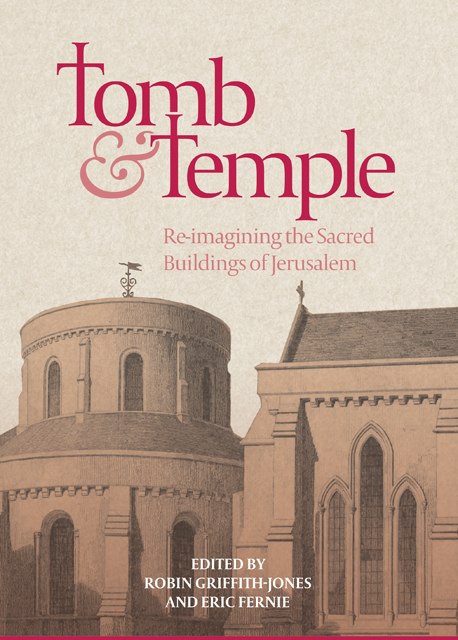Book contents
- Frontmatter
- Contents
- Illustrations
- Preface
- Contributors
- Abbreviations
- Editors’ Note
- Introduction
- Part I Re-presenting Jerusalem
- Part II The Church of the Holy Sepulchre
- Part III The Noble Sanctuary / The Temple Mount
- Part IV The Orthodox Churches
- Part V Round Churches in the West
- Appendix: The Knights’ Effigies: Newly Discovered Drawings by John Guillim, c. 1610
- Epilogue
- Index
- Already Published
5 - Medieval Muslim Veneration of the Dome of the Rock
Published online by Cambridge University Press: 17 January 2023
- Frontmatter
- Contents
- Illustrations
- Preface
- Contributors
- Abbreviations
- Editors’ Note
- Introduction
- Part I Re-presenting Jerusalem
- Part II The Church of the Holy Sepulchre
- Part III The Noble Sanctuary / The Temple Mount
- Part IV The Orthodox Churches
- Part V Round Churches in the West
- Appendix: The Knights’ Effigies: Newly Discovered Drawings by John Guillim, c. 1610
- Epilogue
- Index
- Already Published
Summary
The veneration of the Dome of the Rock in medieval times is a huge topic, and a short chapter can do no more than tilt at it. But even so, given the huge literature on the Dome of the Rock [Colour Pls V–VIII] as a building and as a speaking symbol at the time of its completion in 691 to 692, it is curious that scholars have devoted so much less attention to how it functioned thereafter. The history of its construction, in short, has to some degree obscured its meaning for later Muslims, and in particular what they thought about it and what they did there. And this particular building has a way of transforming itself from one era to the next, constantly acquiring new associations – note, for example, its formidable online presence. So this monument, like the memories that it evokes, is malleable and multivalent.
The Increasing Sanctification Of Jerusalem
It will be convenient to begin with the increasingly intense sanctification of Jerusalem itself, which was especially marked in the Umayyad period. Indeed, many of the sayings of the Prophet Muhammad concerning Jerusalem have been attributed to the second half of the seventh century. There is space here to do no more than allude to the special place of Jerusalem for Muslims as the first direction of prayer (qibla), or to its special role as a place of pilgrimage, especially under the caliph ‘Abd al-Malik (685–705), who built the Dome of the Rock. Indeed, it has been suggested, on the basis of verses declaimed by a Bedouin chieftain of perhaps the sixth or early seventh century, that a sacrificial ceremony was instituted there which had a particular connection with the Umayya tribe, even though this ceremony was probably discontinued after the fall of the Umayyad dynasty in 750. And Jerusalem was venerated as the third holiest city of Islam after Mecca and Madina. Jerusalem was especially dear to those who lived in Palestine.
There is a well-known literary equivalent to this devotion, namely the genre of sacred literature known as the Fada’il al-Quds (‘The Merits of Jerusalem’), examples of which are known to have existed from at least the late ninth century.
- Type
- Chapter
- Information
- Tomb and TempleRe-imagining the Sacred Buildings of Jerusalem, pp. 125 - 145Publisher: Boydell & BrewerPrint publication year: 2018



